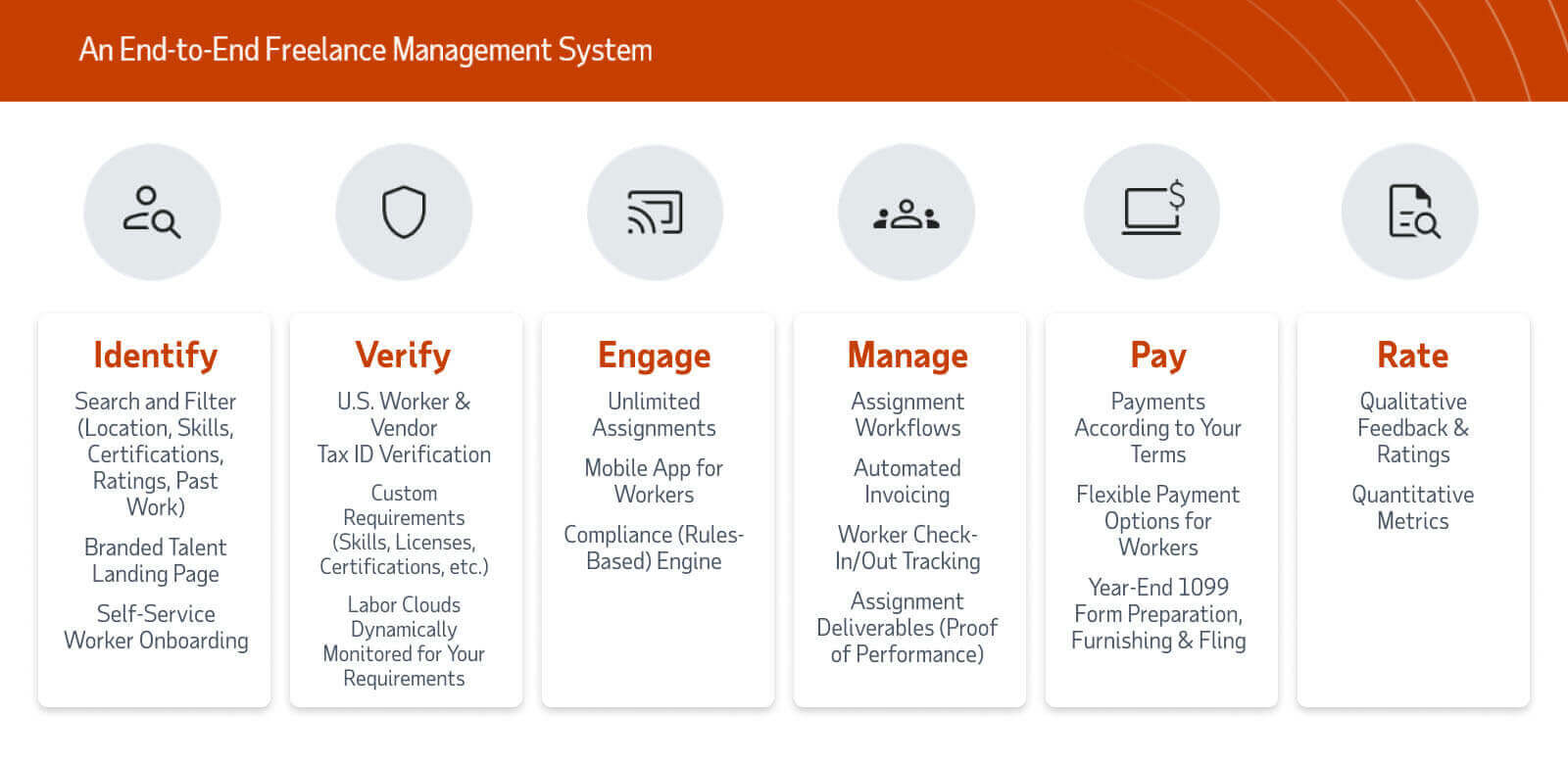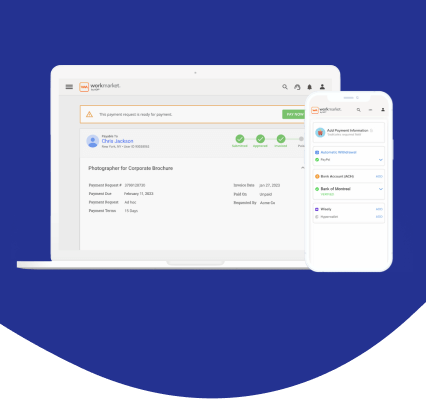The challenge many businesses face as they invest in non-traditional labor is a lack of visibility and control of their extended workforce and related expenses. Managing hundreds, if not thousands, of independent contractors is also time-consuming.
Most organizations have taken a hands-off approach to this problem, leaving the oversight of their extended workforce largely in the hands of managed service providers and hiring managers. Others have relied on dated strategies – disparate technologies, spreadsheets, phone calls, etc. – to find, manage and pay freelancers. These decisions have created fragmented processes that limit the efficiency and effectiveness of talent and workforce management
Businesses today need to become more proactive and engaged if they want to excel in a growing freelance economy that shows no signs of slowing down. By 2050 an estimated 50% of the U.S. workforce will be made up of freelance or contingent workers.1 To keep pace, forward-thinking organizations are relying on freelance management systems.

What is a freelance management system?
An FMS is a cloud-based workforce solution that empowers businesses to manage independent contractors from a single platform. By leveraging this technology, organizations may be able to:
- Identify qualified freelancers
- Automate onboarding processes
- Verify skills, credentials and qualifications
- Organize groups of talent based on business requirements
- Manage on-site and off-site assignments
- Compensate workers with flexible payment options
- Rate performance
- Forecast and control freelance costs
- Engage and communicate with workers on the go
Freelance management software also supports compliance needs and generates auditable paper trails for proper tax reporting.
Why use a freelance management system?
Freelance management software provides the processes and data necessary to help companies compliantly scale an on-demand workforce of hundreds or thousands of independent professionals. Armed with these tools, businesses are more capable of engaging top talent, mitigating risks, planning future staffing needs and controlling labor costs.
Traditionally, organizations managed their extended workforce using several disparate tools, networks and services, i.e., spreadsheets, job boards, project management software, third party payment systems and HR solutions. What’s more, engagements with independent contractors were often handled in a “one off” fashion, which made consolidated reporting, payments and compliance with uniform policies difficult.
With global businesses spending millions on non-traditional talent, they can no longer afford to rely on these outdated methods. FMS gives them a way to manage and measure an incredibly important and rapidly growing segment of their workforce and will help power the future of work.
Benefits of using a freelance management system
Organizations that want to maximize the value of freelancers while mitigating the consequences of disorganized workforce management invest in FMS technology. There are a multitude of benefits to this approach, including:
- Streamlined freelance talent acquisition
Customizable talent landing pages make it easy to assemble a strategic freelance workforce.
- Automated onboarding and organization of workers
Pre-established rules help ensure that freelancers have the appropriate skills, licenses and experience to start work. Businesses can then organize and manage these workers in “labor clouds,” which help integrate operations and ensure that the right people are assigned the right jobs at the right time. - Seamless workflows to better manage assignments
Assignments can be created faster thanks to templates that share common information across projects. And by comparing worker coverage maps to project locations, businesses can identify labor gaps and use artificial intelligence to route assignments to the most qualified matches. - Simple, flexible and convenient payments
Automated invoicing and multiple e-payment options allow businesses to pay independent contractors securely, reliably and on their terms.
- Integrated spend analysis and budget monitoring
FMS technology helps ensure that budgets dedicated to extended workforces are being used for appropriate assignments. Organizations can also better define future freelance expenses based on anticipated needs.
- Reduced compliance risk
Rule-based authentication makes it possible to vet workers on an ongoing basis. Additionally, FMS supports year-end Form 1099-NEC, Nonemployee Compensation reporting.
- Improved data visibility
With executive-level dashboards and automated reports, organizations have insight into every aspect of their freelance workforce. - Enhanced communication and time tracking
State-of-the-art mobile applications allow freelancers to communicate directly with managers, track their assignments and share deliverables in a timely manner. - Verified ratings system
Ratings help ensure that businesses are only working with the freelancers who are most capable of completing assignments effectively and efficiently.
Features of freelance management systems
Compared to spreadsheets, cloud-based technology has extensive capabilities that make it better suited to the unique management needs of freelancers. The six basic FMS features necessary to manage an extended workforce in an end-to-end capacity are:
- Identification
- Verification
- Engagement
- Management
- Payment
- Ratings
Who uses a freelance management system?
Businesses of all sizes and industries work with freelancers, but whether they use an FMS generally depends on volume and frequency. For example, an organization that regularly collaborates with 25 or more freelancers is likely a good candidate for an FMS, whereas an organization that occasionally relies on only a few independent contractors may not be ready for comprehensive technology options.
FMS usage also varies across departments since individual teams tend to have different freelance management needs. Here are some common use cases by stakeholder:
- IT, marketing and sales – onboarding and vetting freelancers, monitoring projects, and checking worker availability
- HR – creating standardized or customized agreements that can serve as templates
- Finance – storing invoices, paying contractors securely and generating paper-trails for future tax filings and insights on freelance expenses
- Legal – verifying freelancer credentials and mitigating compliance risks
When should a business use a freelance management system?
It may be time to begin exploring FMS solutions when organizations:
- Have high-frequency, short-duration assignments that recur by the type of work being done
- Seek to integrate their service ticketing and enterprise resource planning (ERP) systems with a platform that routes work and pays workers
- Want line managers to be more agile and serve their clients faster
- Desire payment flexibility and the ability to integrate with financial systems
- Need help complying with corporate policies, jurisdictional laws or industry regulations
- Have a vast geographic territory or a large, remote extended workforce and are looking to better scale the roll out of their products and services
Frequently asked questions about freelance management systems
How do you manage your freelancers?
Organizations use cloud-based technology to consolidate the management of freelancers onto a single platform so that policies can be implemented uniformly and costs can be analyzed and optimized. Other options include spreadsheets, job boards, project management software, third party payment systems and HR solutions. However, reporting and compliance may be more difficult with these more traditional methods than with freelance management systems.
What is contractor management software?
Contractor management software, also called a freelance management system, is end-to-end technology that manages every stage of the extended workforce lifecycle – identification, verification, engagement, management, payment and rating – all from one platform.
Are there any drawbacks to using an FMS?
Like most other technologies, particularly software as a service solutions, the biggest potential drawbacks to an FMS are system outages, security breaches and perceived costs to implement. However, when working with an industry leading provider, the likelihood of these incidents occurring is minimal. A strong FMS will usually increase ease of use for an organization, enhance its compliance capabilities and drive strong return on investment (ROI).
1Forbes
This article is intended to be used as a starting point in analyzing freelance management systems and is not a comprehensive resource of requirements. It offers practical information concerning the subject matter and is provided with the understanding that ADP is not rendering legal or tax advice or other professional services.




